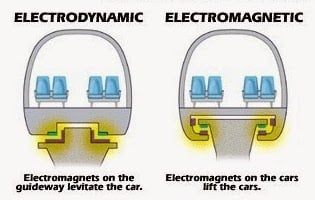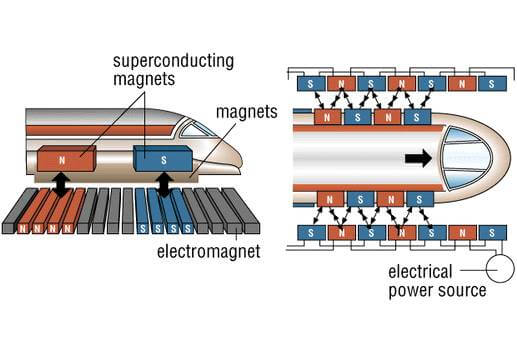- Get link
- X
- Other Apps
- Get link
- X
- Other Apps

The idea of creating a train on magnetic cushions appeared in the early twentieth century, and the first prototype - "Transrapid 02" - was created only in 1971 in the territory of Germany. After 8 years, an advanced model of the maglev was created - "Transrapid 05", the first to receive a license for transportation of passengers. A test track length of 908 meters was built in Hamburg for the exhibition of the IVA 79. The maximum speed of this train was 75 km / h. And the first commercial maglev appeared in 84 in English Birmingham. The 600-meter line connected the airport terminal and the railway station. Simultaneously, work on the creation of the maglev began in Japan, South Korea and China. How does the maglev work - about this in today's issue!

Maglev, or a train on a magnetic cushion, is a compound that is held above the roadway and moves by the strength of the electromagnetic field. The basic property of magnets is based on the maglev: the same poles are repelled, and the different ones are attracted. At the moment, there are two main technologies of magnetic suspension: electromagnetic EMS and electrodynamic EDS.


In the first type of trains under the bottom of the car powerful magnets are mounted in centimeters from the T-shaped steel sheet. When the train moves, the magnetic flux passing through the contour of the web constantly changes, and strong induction currents appear in it. They create a powerful magnetic field that repels the magnetic suspension of the train. The composition levitates by repelling the same poles and attracting different poles of the magnets. A special system keeps the gap between the magnets of 15 millimeters constant. As the gap is increased, the system increases the current in the load-bearing magnets and approximates the car, while decreasing, lowers the current and the gap increases. Also on the electromagnetic magnets set special batteries, allowing the train to levitate when stopped.

Movement of the train is carried out by a linear engine - alternately turns the stator windings, creating a running magnetic field. The stator of the train is drawn into this field and moves the entire train. At the same time, with a frequency of 4000 times per second, the poles change on magnets by alternating current supply. The change in the strength and frequency of the current makes it possible to regulate the speed of the composition.

There is also an electrodynamic EDS-technology, in which the motion of the maglev is due to the interaction of two fields. One of them is created in the roadway, and the second - on the body of the train. Unlike EMS with conventional magnets, EDS uses superconducting electromagnets that can conduct electricity even after the power supply is turned off.
In addition, EDS does not need special systems for adjusting the distance between the train and the canvas. When it is cut, a repulsive force occurs, which returns the magnets to its original position. And with increasing distance, the force of attraction increases, which also leads to stabilization of the system.
Another difference between the trains created by EDS technology is the need for additional wheels when driving at low speeds (up to 150 km / h). When the high speed is reached, the wheels separate from the ground and the train flies a few centimeters from the surface. It is also worth noting that due to strong magnetic fields on the body of the train, magnetic shielding is necessary.
Maglev is the fastest public land transport. The speed record was set by the Japanese train Shinkansen L0 in April 2015 - it accelerated to 603 km / h.

The article is based on materials .
- Get link
- X
- Other Apps
Comments
Post a Comment